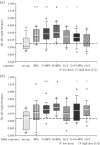Environmental levels of oestrogenic and antiandrogenic compounds feminize digit ratios in male rats and their unexposed male progeny
- PMID: 23926155
- PMCID: PMC3757980
- DOI: 10.1098/rspb.2013.1532
Environmental levels of oestrogenic and antiandrogenic compounds feminize digit ratios in male rats and their unexposed male progeny
Abstract
Digit length ratios, especially the second-to-fourth digit ratio (2D : 4D), are associated with various pathological and behavioural conditions in many species including humans and are dependent upon prenatal androgen to oestrogen balance. It is unknown whether digit ratios are modified by environmental exposure to ubiquitous endocrine disruptors. We studied the effect on adult male Wistar rat digit ratios of a gestational exposure to the oestrogenic and antiandrogenic compounds bisphenol A (BPA), genistein and vinclozolin, in low doses, and in combination with investigating in parallel a possible sexual dimorphism of this trait. We also investigated the effects on the male progeny not exposed during gestation. X-rays were taken of the left and right forepaws, and 2D-5D proximal to distal phalanx distances were measured by a standardized procedure based on semi-automatic image analysis. We provide evidence that there is a sexual dimorphism of digit ratios in the Wistar rat, and we found that BPA alone or in combination with genistein and vinclozolin significantly feminized digit ratios in male rats. Intriguingly, significant feminization of digit ratios was also found in the unexposed male progeny of males that had been exposed to compound mixtures. In conclusion, prenatal environmental levels of endocrine-active substances permanently disrupt digit ratios. Digit ratio measurement in adults is thus a promising biomarker of prenatal exposure to low-dose endocrine disruptors in rodents, with potential implications for future studies in humans.
Keywords: 2D : 4D; bisphenol A; endocrine disruptor; endocrine-active substance; genistein; vinclozolin.
Figures


References
-
- Galis F, Ten Broek CM, Van Dongen S, Wijnaendts LC. 2010. Sexual dimorphism in the prenatal digit ratio (2D : 4D). Arch. Sex. Behav. 39, 57–62 (doi:10.1007/s10508-009-9485-7) - DOI - PMC - PubMed
-
- Lutchmaya S, Baron-Cohen S, Raggatt P, Knickmeyer R, Manning JT. 2004. 2nd to 4th digit ratios, fetal testosterone and estradiol. Early Hum. Dev. 77, 23–28 (doi:10.1016/j.earlhumdev.2003.12.002) - DOI - PubMed
-
- Manning JT, Bundred PE. 2000. The ratio of 2nd to 4th digit length: a new predictor of disease predisposition? Med. Hypotheses 54, 855–857 (doi:10.1054/mehy.1999.0000) - DOI - PubMed
-
- Manning JT, Baron-Cohen S, Wheelwright S, Sanders G. 2001. The 2nd to 4th digit ratio and autism. Dev. Med. Child Neurol. 43, 160–164 (doi:10.1111/j.1469-8749.2001.tb00181.x) - DOI - PubMed
-
- Rahman AA, et al. 2011. Hand pattern indicates prostate cancer risk. Br. J. Cancer 104, 175–177 (doi:10.1038/sj.bjc.6605986) - DOI - PMC - PubMed
Publication types
MeSH terms
Substances
LinkOut - more resources
Full Text Sources
Other Literature Sources

